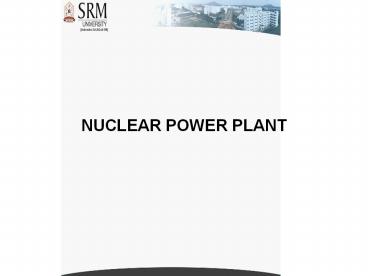NUCLEAR POWER PLANT - PowerPoint PPT Presentation
1 / 18
Title:
NUCLEAR POWER PLANT
Description:
NUCLEAR POWER PLANT NUCLEAR FUEL Nuclear fuel is any material that can be consumed to derive nuclear energy. The most common type of nuclear fuel is fissile elements ... – PowerPoint PPT presentation
Number of Views:231
Avg rating:3.0/5.0
Title: NUCLEAR POWER PLANT
1
NUCLEAR POWER PLANT
2
- NUCLEAR FUEL
- Nuclear fuel is any material that can be consumed
to derive nuclear energy. The most common type of
nuclear fuel is fissile elements that can be
made to undergo nuclear fission chain reactions
in a nuclear reactor - The most common nuclear fuels are 235U and
239Pu. Not all nuclear fuels are used in fission
chain reactions
3
- NUCLEAR FISSION
- When a neutron strikes an atom of uranium, the
uranium splits ingto two lighter atoms and
releases heat simultaneously. - Fission of heavy elements is an exothermic
reaction which can release large amounts of
energy both as electromagnetic radiation and as
kinetic energy of the fragments
4
- NUCLEAR CHAIN REACTIONS
- A chain reaction refers to a process in which
neutrons released in fission produce an
additional fission in at least one further
nucleus. This nucleus in turn produces neutrons,
and the process repeats. If the process is
controlled it is used for nuclear power or if
uncontrolled it is used for nuclear weapons
5
6
- U235 n ? fission 2 or 3 n 200 MeV
- If each neutron releases two more neutrons, then
the number of fissions doubles each generation.
In that case, in 10 generations there are 1,024
fissions and in 80 generations about 6 x 10 23 (a
mole) fissions.
7
8
- NUCLEAR REACTOR
- A nuclear reactor is a device in which nuclear
chain reactions are initiated, controlled, and
sustained at a steady rate, as opposed to a
nuclear bomb, in which the chain reaction occurs
in a fraction of a second and is uncontrolled
causing an explotion.
9
- CONTROL RODS
- Control rods made of a material that absorbs
neutrtons are inserted into the bundle using a
mechanism that can rise or lower the control
rods. - . The control rods essentially contain neutron
absorbers like, boron, cadmium or indium.
10
- STEAM GENERATORS
- Steam generators are heat exchangers used to
convert water into steam from heat produced in a
nuclear reactor core. - Either ordinary water or heavy water is used as
the coolant.
11
- STEAM TURBINE
- A steam turbine is a mechanical device that
extracts thermal energy from pressurized steam,
and converts it into useful mechanical - Various high-performance alloys and superalloys
have been used for steam generator tubing.
12
- COOLANT PUMP
- The coolant pump pressurizes the coolant to
pressures of the orderof 155bar. - The pressue of the coolant loop is maintained
almost constant with the help of the pump and a
pressurizer unit.
13
- FEED PUMP
- Steam coming out of the turbine, flows through
the condenser for condensation and recirculated
for the next cycle of operation. - The feed pump circulates the condensed water in
the working fluid loop.
14
- CONDENSER
- Condenser is a device or unit which is used to
condense vapor into liquid. - The objective of the condenser are to reduce the
turbine exhaust pressure to increase the
efficiency and to recover high qyuality feed
water in the form of condensate feed back it to
the steam generator without any further
treatment.
15
- COOLING TOWER
- Cooling towers are heat removal devices used to
transfer process waste heat to the atmosphere. - Water cirulating throughthe codeser is taken to
the cooling tower for cooling and reuse
16
- ADVANTAGES
- Nuclear power generation does emit relatively low
amounts of carbon dioxide (CO2). The emissions of
green house gases and therefore the contribution
of nuclear power plants to global warming is
therefore relatively little. - This technology is readily available, it does not
have to be developed first. - It is possible to generate a high amount of
electrical energy in one single plant
17
- DISADVANTAGES
- The problem of radioactive waste is still an
unsolved one. - High risks It is technically impossible to build
a plant with 100 security. - The energy source for nuclear energy is Uranium.
Uranium is a scarce resource, its supply is
estimated to last only for the next 30 to 60
years depending on the actual demand.
18
- DISADVANTAGES
- Nuclear power plants as well as nuclear waste
could be preferred targets for terrorist
attacks.. - During the operation of nuclear power plants,
radioactive waste is produced, which in turn can
be used for the production of nuclear weapons.































